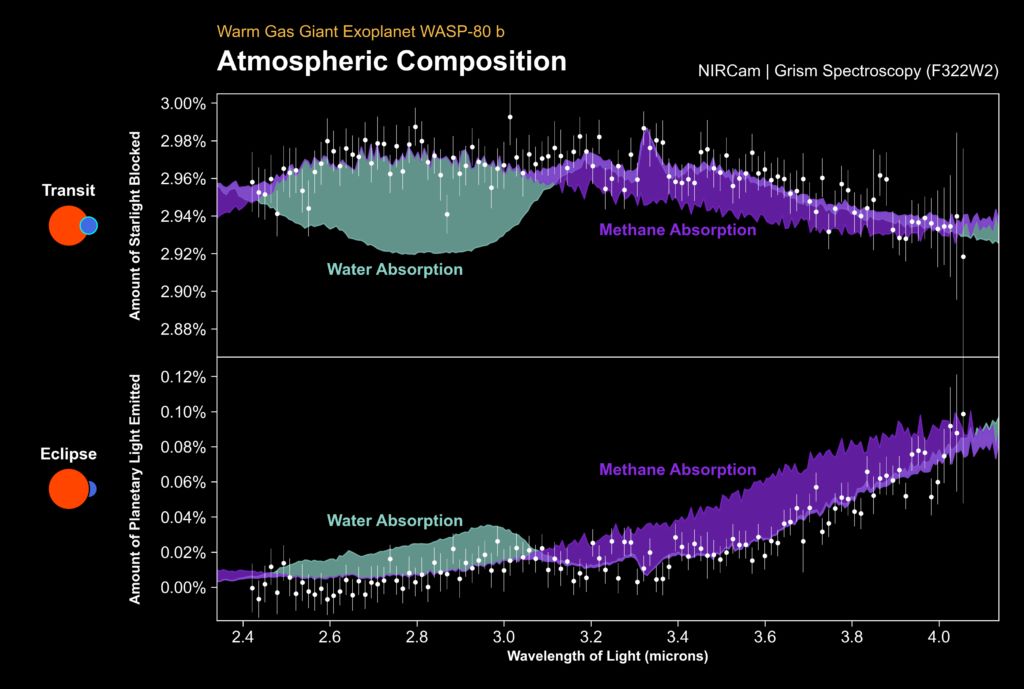Methane has been found in Jupiter’s, Saturn’s, Uranus’s, and Neptune’s atmospheres within our solar system. However, its presence remained elusive in the atmospheres of transiting exoplanets.
NASA’s James Webb Space Telescope observed the exoplanet WASP-80 b as it passed before and behind its host star. The telescope detected methane gas and water vapor in the planet’s atmosphere.
Being called ‘Hot Jupiter’, the exoplanet WASP-80 b has a temperature of about 825 kelvins (about 1,025 degrees Fahrenheit). Located 163 light-years away from Earth in the constellation Aquila, the exoplanet orbits its red dwarf star once every three days.
Because of its proximity to its star, both so far away from us, we can’t see the planet directly with even the most advanced telescopes like Webb.
So, how did scientists identify the planet?
Scientists studied the combined light from the star and planet using the transit and eclipse methods. The transit method helped them observe the system when the planet moved before its star. The starlight they saw was dim a bit.
It’s similar to when the light dims when someone walks before a lamp. Around the planet’s day/night boundary, a thin ring of the atmosphere is illuminated by the star during this period. The atmosphere appears thicker and blocks more starlight at specific wavelengths where its molecules absorb light, resulting in a deeper dimming than at other wavelengths where the atmosphere seems transparent.
By identifying the hues of light that are being blocked, this technique aids scientists in understanding the composition of the planet’s atmosphere.
On the other hand, using the eclipse method, scientists observed the system from their perspective as the planet passed behind its star, causing another slight dip in the total light they received. Thermal radiation is a type of light that all objects release; the amount and hue of the light emitted depend on how hot the object is.
The planet’s hot dayside faces us just before and after the eclipse, so scientists could measure the infrared light the planet was emitting by observing the dip in light that occurred during the eclipse.
Absorption by molecules in the planet’s atmosphere usually manifests itself in eclipse spectra as a decrease in the planet’s light emission at particular wavelengths. Additionally, the depth of an eclipse is significantly less than the depth of a transit since the Earth is much smaller and more relaxed than its host star.

These initial observations needed to be transformed into a spectrum.
Scientists noted, “Many different tools exist to transform raw observations into useful spectra, so we used two different approaches to make sure our findings were robust to different assumptions.”
“Next, we interpreted this spectrum using two kinds of models to simulate what the atmosphere of a planet under such extreme conditions would look like. The first model type is entirely flexible, trying millions of combinations of methane and water abundances and temperatures to find the combination that best matches our data.”
“The second type, called ‘self-consistent models,’ also explores millions of combinations but uses our existing knowledge of physics and chemistry to determine the levels of methane and water that could be expected. Both model types reached the same conclusion: a definitive methane detection.”
Scientists next validated the findings through robust statistical methods by evaluating the probability of their detection being random noise.
They found methane at 6.1-sigma in both the eclipse and transit spectra, exceeding the 5-sigma “gold standard”. It increased scientists’ confidence in both detections by placing the odds of a spurious detection in each observation at 1 in 942 million.
Scientists are now looking forward to exploring the planet’s chemical composition that reveals the planet’s birth, growth, and evolution.
Scientists noted, “For example, by measuring the amount of methane and water in the planet, we can infer the ratio of carbon atoms to oxygen atoms. This ratio is expected to change depending on where and when planets form in their system. Thus, examining this carbon-to-oxygen ratio can indicate whether the planet formed close to its star or farther away before gradually moving inward.”
Journal Reference:
- Bell, T.J., Welbanks, L., Schlawin, E. et al. Methane throughout the atmosphere of the warm exoplanet WASP-80b. Nature 623, 709–712 (2023). DOI: 10.1038/s41586-023-06687-0
Note: This article have been indexed to our site. We do not claim legitimacy, ownership or copyright of any of the content above. To see the article at original source Click Here












